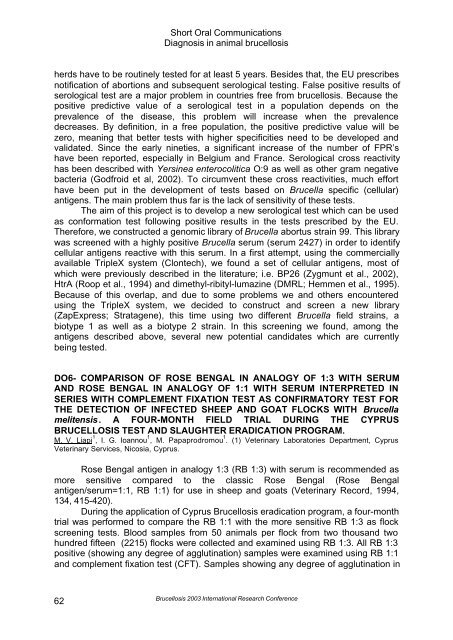Brucellosis 2003 proceedings - PHIDIAS
Brucellosis 2003 proceedings - PHIDIAS
Brucellosis 2003 proceedings - PHIDIAS
Create successful ePaper yourself
Turn your PDF publications into a flip-book with our unique Google optimized e-Paper software.
Short Oral Communications<br />
Diagnosis in animal brucellosis<br />
herds have to be routinely tested for at least 5 years. Besides that, the EU prescribes<br />
notification of abortions and subsequent serological testing. False positive results of<br />
serological test are a major problem in countries free from brucellosis. Because the<br />
positive predictive value of a serological test in a population depends on the<br />
prevalence of the disease, this problem will increase when the prevalence<br />
decreases. By definition, in a free population, the positive predictive value will be<br />
zero, meaning that better tests with higher specificities need to be developed and<br />
validated. Since the early nineties, a significant increase of the number of FPR’s<br />
have been reported, especially in Belgium and France. Serological cross reactivity<br />
has been described with Yersinea enterocolitica O:9 as well as other gram negative<br />
bacteria (Godfroid et al, 2002). To circumvent these cross reactivities, much effort<br />
have been put in the development of tests based on Brucella specific (cellular)<br />
antigens. The main problem thus far is the lack of sensitivity of these tests.<br />
The aim of this project is to develop a new serological test which can be used<br />
as conformation test following positive results in the tests prescribed by the EU.<br />
Therefore, we constructed a genomic library of Brucella abortus strain 99. This library<br />
was screened with a highly positive Brucella serum (serum 2427) in order to identify<br />
cellular antigens reactive with this serum. In a first attempt, using the commercially<br />
available TripleX system (Clontech), we found a set of cellular antigens, most of<br />
which were previously described in the literature; i.e. BP26 (Zygmunt et al., 2002),<br />
HtrA (Roop et al., 1994) and dimethyl-ribityl-lumazine (DMRL; Hemmen et al., 1995).<br />
Because of this overlap, and due to some problems we and others encountered<br />
using the TripleX system, we decided to construct and screen a new library<br />
(ZapExpress; Stratagene), this time using two different Brucella field strains, a<br />
biotype 1 as well as a biotype 2 strain. In this screening we found, among the<br />
antigens described above, several new potential candidates which are currently<br />
being tested.<br />
DO6- COMPARISON OF ROSE BENGAL IN ANALOGY OF 1:3 WITH SERUM<br />
AND ROSE BENGAL IN ANALOGY OF 1:1 WITH SERUM INTERPRETED IN<br />
SERIES WITH COMPLEMENT FIXATION TEST AS CONFIRMATORY TEST FOR<br />
THE DETECTION OF INFECTED SHEEP AND GOAT FLOCKS WITH Brucella<br />
melitensis. A FOUR-MONTH FIELD TRIAL DURING THE CYPRUS<br />
BRUCELLOSIS TEST AND SLAUGHTER ERADICATION PROGRAM.<br />
M. V. Liapi 1 , I. G. Ioannou 1 , M. Papaprodromou 1 . (1) Veterinary Laboratories Department, Cyprus<br />
Veterinary Services, Nicosia, Cyprus.<br />
Rose Bengal antigen in analogy 1:3 (RB 1:3) with serum is recommended as<br />
more sensitive compared to the classic Rose Bengal (Rose Bengal<br />
antigen/serum=1:1, RB 1:1) for use in sheep and goats (Veterinary Record, 1994,<br />
134, 415-420).<br />
During the application of Cyprus <strong>Brucellosis</strong> eradication program, a four-month<br />
trial was performed to compare the RB 1:1 with the more sensitive RB 1:3 as flock<br />
screening tests. Blood samples from 50 animals per flock from two thousand two<br />
hundred fifteen (2215) flocks were collected and examined using RB 1:3. All RB 1:3<br />
positive (showing any degree of agglutination) samples were examined using RB 1:1<br />
and complement fixation test (CFT). Samples showing any degree of agglutination in<br />
62<br />
<strong>Brucellosis</strong> <strong>2003</strong> International Research Conference
















